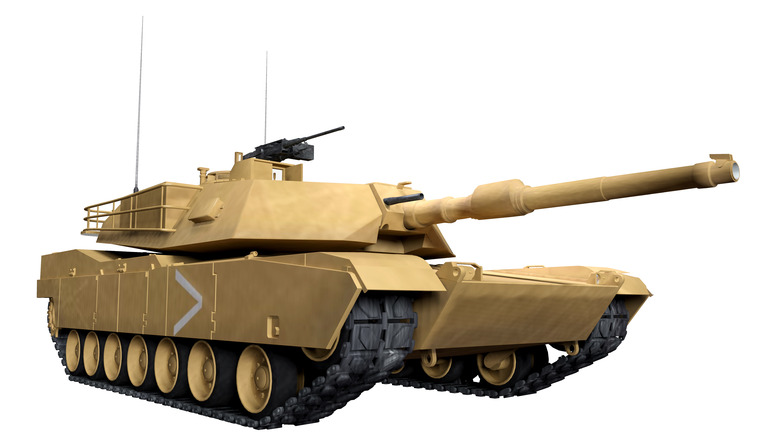Why The Panther KF51 Has The Tank Community So Impressed
The history of the tank is long and storied. From the Sherman tanks and Panzers of WWII to the M-1 Abrams and T-90s of today, the development of tank technology has been steady and competitive. Bigger guns firing better ammunition, better armor and threat protection, and digital networking on the battlefield have combined to keep the tank relevant to modern warfare. Germany's new KF51 Panther tank is generating interest not only because it seems to be the next step in the offensive one-upmanship that has driven tank development until now but also because of its improved armor that was designed to counter the threats tanks are facing today, and the electronic sophistication that will let it use its capabilities to their fullest effect.
Although it has not yet been adopted by any nation's military (having been introduced in 2022) and is still in testing, the Panther is a forward-looking model that looks as future-proofed as a tank can be. Its main chassis is based on the fast and agile Leopard 2A4, but the turret is new and improved. It also incorporates a host of new features that will help the tank deal with today's high-tech battlefield. Let's review them.
Offense
A tank with a larger main gun can not only pack more destructive force into each shot — they can do it from farther away, out of range of opposing tanks. The KF51 Panther is equipped with a 130-millimeter caliber main gun. Compare that with the 120-millimeter gun of the M1 Abrams or the 125-millimeter gun of the Russian Armata. To compound the advantage of superior firepower, the gun is auto-loading, yielding three benefits: the tank can fire faster; the tank's turret can now be unmanned, sparing a soldier from having their station at the most dangerous part of the vehicle; and the crew necessary to operate the Panther is reduced to three.
Of course, a good tank's offensive capabilities cannot be confined to its main gun. The KF51 Panther carries a coaxial machine gun that can be loaded with one of several options, including an RCWS (remote-controlled weapon system) that keeps the gunner inside the tank while they defend it. But the Panther has a highly modern, rather sneaky extra punch it can throw.
The turret of the KF51 can be equipped with a launcher for the HERO 120 loitering munition — otherwise known as a drone. The HERO 120 has a range of over 30 miles and can stay aloft for an hour. This is a game-changer with multiple ways to help a tank win a battle, from flying over a hilltop to check for opposing forces to staying behind to cover the tank's withdrawal. This special offensive tool effectively increases the lethal range of the Panther by miles.
Defense
The Panther employs advanced three-layer armor that employs active, reactive, and passive protections that can protect against kinetic energy weapons and anti-tank missiles without depriving the Panther of its speed by weighing it down. It supplements this with a TAPS (Top Attack Protection System) to protect against top-down attacks on the turret, a common angle of attack for anti-tank missiles.
The KF51 has an extensive smoke system to obscure the tank from being targeted visually. Its sensors can detect enemy fire and use it to target opposing forces. Once an enemy vehicle has been located, the installed HERO drones can defend the tank from miles away. Of course, drones and targeting computers that use AI only help if they are operational. For this reason, the Panther is fully cyber-hardened.
Of course, speed is a defensive capability as well, and the Panther's top speed of 65 kilometers/hour will help protect it while in use, as will its 500-kilometer range. The crew is further protected by NBC (nuclear/biological/chemical) defenses and automatic fire suppression.
Network capabilities
The combined-arms approach of today's more sophisticated militaries requires network communication that is not only reliable and instantaneous but also resistant to the counter-measures of the enemy. The KF51 is so closely and securely networked with its battlefield colleagues that its manufacturer, Rheinmetall, calls it "a truly software-defined tank." Its digital sophistication yields an array of advantages and abilities.
Any station inside the Panther can take over and perform any function, so the operation of the tank's sensors and weapons can be transferred between crew members. Since the turret and weapons can also be controlled from the operator stations in the chassis, variants of the KF51 Panther that are completely unmanned are planned for the future. A Panther crewperson can also take over unmanned "wingman" versions of the tank (and other vehicles) and control them directly. It is only a matter of time before this can be accomplished remotely as well.
Then there is the HERO drone. The Panther can use them for targeting information or to destroy the target directly. And the targeting information gathered can be made available to other tanks, planes, and command centers. This creates an integrated function between all the units on the battlefield, allowing for coordinated ISTAR (Intelligence, Surveillance, Target Acquisition, and Reconnaissance).
Who will use it?
Nations with extensive militaries are constantly researching better planes, guns, and tanks (such as the K2 Black Panther) while also spying on each other to see what new capabilities have to be either matched or defended against. In this competitive environment, it's hard to say how long the Panther will remain the cutting-edge tank it surely is now as it is newly released. But that has not stopped other countries from expressing great interest in the Panther.
One country that has made its admiration for the new tank model known is Hungary. Germany's EU partner will help develop (mainly a new chassis) and then manufacture the updated model. Germany will stick with its late-model Leopards for the time being — the Panther is less expensive to build than the Leopard, but an existing fleet of tanks is always cheaper than building a new one.
The most interesting party to show interest, given current events, is Ukraine. Rheinmetall has also offered to build a tank factory in Ukraine, though there is some question as to whether it would build Panthers or Leopards since the ultra-advanced Panther would be harder to integrate into the existing Ukrainian military. In any event, given the amount of copycatting that goes on between the world's militaries, the advanced technology and unmatched hitting power of the KF51 will no doubt be popping up in other nations' armies under other names, since it is legitimately, at the moment, the most dangerous tank in the world.




